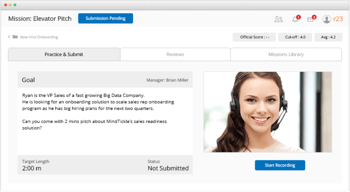1 min read
Most Staffing Firms are Not Built to Scale, But to Survive
Most staffing firms don’t struggle to scale because their teams aren’t working hard. They struggle because they don’t have a real go-to-market...
7 min read
![]() Dan Fisher
:
Mar 4, 2021 2:24:24 PM
Dan Fisher
:
Mar 4, 2021 2:24:24 PM

With sales enablement and sales enablement software rapidly gaining traction - the number of companies with a full time dedicated sales enablement role has more then tripled since 2013. But while adoption has accelerated, so too has confusion around the related technology.
accelerated, so too has confusion around the related technology.
Part of the challenge is many of the industry analysts such as CSO Insights, Forrester, Gartner, Aberdeen, etc., use different terminology to describe the many different sales enablement tools and software that exist on the market today.
Additionally, many of today's sales enablement software products offer multiple functionality which also creates confusion. When you take all of that into consideration along with the number of sales enablement technology providers, it's no surprise things get a little murky! The sales enablement software market was valued $1.1 billion in 2019, and is projected to grow to $2.6 billion by 2024. So no, it's not just a passing fad or marketing jargon. Sales enablement software delivers legit business value.
What is Sales Enablement Software?
The term "sales enablement software" is broad and can mean different things to different people. If you google the term "sales enablement software" many of the results will say things like "a repository for marketing collateral and sales playbooks" or "allows your team to manage all of your materials and content from a central location." But these terms only reflect one aspect of sales enablement software, managing marketing content. As you will learn, there are many different facets to sales enablement software.
If you're new to sales enablement then you might want to check out our eBook, The Staffing Leaders Guide to Sales Enablement, but generally speaking, sales enablement software is designed to enable customer facing professionals and their managers to add value at each touch point of the buyer journey with the goal of achieving repeatable and scalable sales results. It's purpose is to improve sales productivity and sales effectiveness, all of which adds value to your organization.
There are a wide spectrum of tools, ranging in features and functionality. Some are "enterprise" solutions encompassing all sales enablement functionality into a single software platform while others are more "point solutions" focused on solving a specific challenge. What is best about most sales enablement tools is you really do NOT have to be a big company to take advantage of, or afford them. Technology continues to get cheaper making it more affordable for even the smallest of start-ups.
At a high-level, there are different types of sales enablement software to support salespeople in a variety of different ways. Forrester Research highlights three types of sales enablement software that are “rapidly becoming foundational to the 21st century sales tech stack.”
Sales Content Management
The Challenge: Today's modern (and ultra informed) buyer is seeking specific content at each stage of their buying journey. For example, buyers in the awareness stage seek content that provides relevant ideas and insights into their industry and their business challenges while buyers in the decision stage seek other content such as ROI tools and calculators and relevant customer case studies. Your sales reps know this and want great content so that they can more effectively position their offerings and demonstrate credibility with their buyers.
However, even if you're producing highly relevant and valuable content, it might either be difficult to find or difficult to identify which piece of content would best serve a particular buyer and where they reside in the buyer's journey. Perhaps you've heard or seen statistics like, “80% of marketing-generated content goes unused by sales teams or "salespeople spend 30% of their time curating or creating content."
The Solution: Sales content management software is designed to help you produce, store, organize, and distribute content that your sales team uses to sell their services/solutions. The objective is to shorten the conversion time from an initial conversation to a paying customer.
Sales content management software allows you to organize content into relevant categories. Instead of just hosting your case studies on a company shared drive, content management software allows you to more effectively promote and catalogue those case studies. For example, as an IT staffing firm you could tag each case study based on:
This enables your sellers to quickly and easily access the right case study for the most relevant buyer, at the right time. The key with sales content management software is that it makes the content easily discovered via search and adds descriptions and instructions to help reps use the content. After all, what is the point of content if you people can't find it?
Examples: Seismic, Showpad
Learning Management (LMS) Software:
The Challenge: What if my business were to move to a virtual environment where my recruiters and salespeople worked from home? That sounds all too familiar, right? How do I deliver an engaging training experience virtually? How do I onboard my new hires? How do I upskill my tenured employees and keep them informed and engaged? Learning management software solves these challenges.
LMS software also answers the question of, "how can I enhance and scale my existing, live, instructor-led classroom training so that my team to consume training anywhere, anytime?
Solution: Using LMS software makes things easier for you, as it helps plan the training activities including training invites which you share with your learners and trainer. A learning management system also gives you a platform in which you can "house" your training assets which helps you maintain and improve your training process. With most LMS platforms you can also track and manage learner registration, learner progress and course administration. Moving your sales and recruiter training online is often the first steps an organization takes and a prelude for adopting sales enablement as internal core competency.
The LMS software market is crowded and the functionality and capability can very by a wide margin. Cornerstone, Blackboard, Skillsoft and Absorb are all popular LMS platforms. With an LMS you have the ability to build and store a library of content and administer courses, and invite and track learners. What is important to know is that, LMS software is designed for content authoring.
Remember your first smart phone? Pretty rudimentary compared to the smart phone you hold in your hand today right? While LMS software still plays an important role in content authoring, it is also a bit outdated and has been surpassed by sales readiness software (in most cases sales readiness software has an LMS "baked" into the platform). Forward-thinking Learning & Development (L&D) leaders recognized long ago that in order to demonstrate their value and elevate their role in the organization they needed to show quantifiable results. The shortfall of LMS is they were never designed to deliver training outcomes. This is why you read and hear all the buzz about sales enablement and sales readiness software, which is the perfect lead-in to our next topic.
Video Simulation Software for Skill, Knowledge Certification (Sales Readiness)
Challenge: According to Forrester Research, only 19% of the more than 400 US-based IT and Executive Buyers surveyed believe that their time spent with salespeople is valuable and lives up to their expectations. And a study from salesforce.com shows that 79% of buyers say it’s absolutely critical or very important to interact with a salesperson who is a trusted advisor. Simply put, sellers who can’t add value at each stage of the buyer’s journey will struggle.
But most front line sales and recruiting managers lack the bandwidth to consistency engage in role play practice every day with their people. Not only does it take time to engage in the actual role plays and provide coaching but it takes time to think through and design the role play scenarios and evaluation criteria. If that weren't enough, how do you do this at scale, for all of your sellers and all of your recruiters?
The Solution: Video Simulation Software gives teams a safe and controlled environment where they can practice and perfect their their most important conversations such as the discovery call, or getting candidate interview feedback and overcoming objections.
Video simulation takes the guess-work out of whether or not your employees can execute what was taught in training. It also allows you to reinforce and drive adoption of your training and certify your people are "conversation ready" across each stage of the buyer's journey. At a macro-level it drives predictable performance by enabling more of your producers to deliver like your top performers.
buyer's journey. At a macro-level it drives predictable performance by enabling more of your producers to deliver like your top performers.
Examples: Mindtickle, Allego
Sales Engagement Software
The Challenge: As staffing firms focus on KPIs such as outbound emails to meetings, discovery calls to job orders, candidate submittals to interviews and interviews to offer ratios, they want their teams using the most effective outreach tactics at scale.
This is especially true when you consider how little time sales reps spend actually meeting with and engaging prospects and customers. Hubspot reports that reps spend 21% of their day writing emails, 17% entering data, and another 17% prospecting and researching leads. Sales productivity is a struggle for today’s sellers!
The Solution: Sales engagement software focuses on optimizing the selling process by providing a single interface that helps sellers plan, execute, track, measure, and optimize interactions with customers across each stage of the sales process and across multiple channels. They do this by streamlining all the ways reps communicate with prospects – email, phone, social, etc. This allows sales teams to save time while converting more of their prospects into customers.
This is the type of software people use or think of when they hear "sales campaign management" or "lead nurturing." One of the key aspects of sales engagement software is to help salespeople transition from unstructured, haphazard prospecting efforts to one that is highly structured and regimented in which you can track and measure results.
For example, if a prospective customer just released a new product, sales reps can send a series of targeted, timed email to nurture contacts in that account over time. You can also automatically create tasks to remind you to follow up with your contacts. Many of these software tools also allow reps to track clicks and open rates on emails sent, and replicate the most effective templates for future use.
Examples: Salesloft, Outreach, Groove, Hubspot
As you can see, there are several different "categories" of sales enablement software, each providing different capabilities and functionality. Hopefully from reading this article you've gained some clarity regarding which tools your team needs to your goals.
In part two I will cover other types of sales enablement software including video and AI powered coaching, sales forecasting, CRM and sales conversation intelligence.

1 min read
Most staffing firms don’t struggle to scale because their teams aren’t working hard. They struggle because they don’t have a real go-to-market...

In my previous post, How to Prevent Unexpected Contract Terminations, I shared how systemizing consultant and client check-ins at key milestones...

About a year ago, I was serving as the fractional revenue leader, managing sales and recruiting for a client.